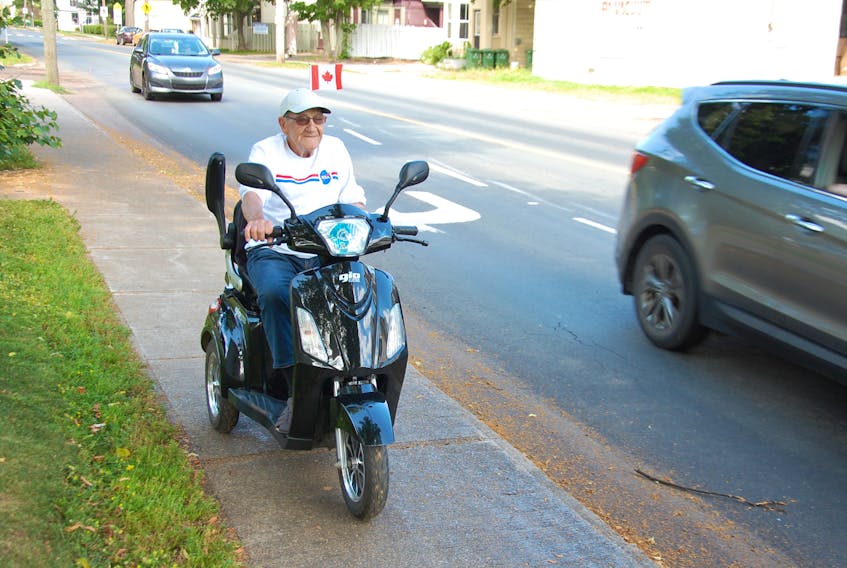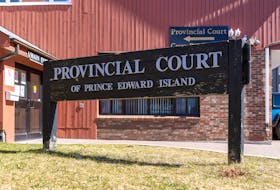CHARLOTTETOWN, P.E.I. — Vern Watson puttered around Charlottetown on his motorized mobility scooter for five or six years.
He travelled no faster than a good jogging pace, staying on the sidewalk all the time.
Two years ago, the veteran upgraded to a far more powerful GIO electric scooter.
That baby hums along in comparison to his previous mode of transportation.
“It probably would do about 30 clicks (km/h),’’ he says.
“I can get out to the mall quicker.’’
Unlike the previous scooter, Watson ventures onto the road with the GIO when the sidewalk is too rough.
Still, he considers himself a pedestrian, not a motorist.
Watson says he is not nervous being on the road as motor vehicles speed past his scooter, which is equipped with headlights and four-way flashers.
“They stop for me, I stop for them,’’ he says.
Under provincial regulations, though, Watson is deemed a pedestrian. He does not belong on the road when the use of a sidewalk is viable.
When the sidewalk is too difficult to operate on due to poor condition, he and others on similar devices should drive on the shoulder of the road facing traffic, as a pedestrian would, to “see what is coming at you to give you time to get out of the way,’’ says Graham Miner, director of the Highway Safety Division.

However, adds Miner, the distinction between motorist and pedestrian is growing increasingly blurry.
“The concern that comes out of this is that now a number of these devices are getting wider, they’re getting faster and they’re heavier,’’ he says.
“Some of these can do 20, 30, 40, upwards of 50 kilometres per hour. Of course, you don’t want those on the sidewalk because you’re interacting with pedestrians.’’
Conversely, many Islanders are venturing into motor vehicle traffic on motorized personal mobility scooters (MPMS) best suited for the sidewalk.
“What that means for those that operate those (scooters), they must follow the rules of the road that pedestrians do,’’ says Miner.
“If you start breaking the rules of a pedestrian with one of these devices, then you are in jeopardy of being in open traffic, which is not a good place to be.’’
He says studies show a significant number of injuries and fatalities occur when people on scooters and electric wheelchairs interact with motor vehicles.
He says police and motorists raise concerns about people riding in the middle of traffic on motorized personal mobility scooters.
He says it is not uncommon to see a person travelling 15 or 20 km/hr on a motorized personal mobility scooter in motor vehicle traffic that is moving three times that speed or faster.
“That is a huge concern because they are really in a desperate situation,’’ he says.
“There is no protection, and if there is a collision you know who is going to lose.’’
Miner says many are trying to get a better handle on what should be classified as pedestrian and what should fall under motor vehicle.
“It is under review quite a bit across the country and in the U.S…it’s quite a fluid topic right now because the technology is changing so rapidly in relation to where the vehicles belong or don’t belong depending on what’s happening with them.’’
Miner says able-bodied people are increasingly using the faster, larger so-called medical scooters as their preferred means of transportation.
More and more motors, he adds, are ending up on bicycles and skateboards.
“Anything you can put a motor on eventually gets itself out on the road and then the question is, ‘is it allowed to be there?’ If it is a motor vehicle and it is on the roadway, you have to have a driver’s licence and you have to have a registration.’’
Provinces and territories are responsible for regulations dealing with the registration of vehicles, licencing of drivers and operation of motor vehicles.
He urges Islanders who own or plan to purchase a motorized personal mobility device to learn applicable rules and regulations before venturing out for a ride.
Miner has been reviewing, along with the Canadian Council of Motor Transport Administrators, the issue of putting pedestrians and motorists in their proper place.
“It’s an emerging field and it is moving quickly,’’ he says.
“It’s moving very fast. Almost everything has a motor on it now.’’









